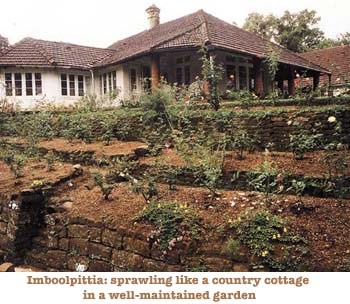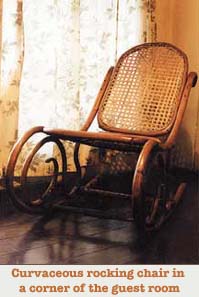

![]()
Secluded in hillside tea plantations are bungalows recalling part of Sri Lanka's recent past. Royston Ellis and photographer Gemunu Amarasinghe set out to discover some of them in this fortnightly series........
 Plantation
lore suggests that the sprawling bungalow of Imboolpittia used to be a
club house and in those days had only two rooms. Now it has expanded so
much that when two sets of visitors were there at the same time recently,
they didn't meet.
Plantation
lore suggests that the sprawling bungalow of Imboolpittia used to be a
club house and in those days had only two rooms. Now it has expanded so
much that when two sets of visitors were there at the same time recently,
they didn't meet.
The Imboolpittia bungalow is actually small compared with most estate houses. It has a master bedroom and a wing containing two guest rooms with a shared bathroom between them. However, it has grown in such a manner, there is no pattern to it and, surprisingly, it is easy for the visitor to get lost within its walls.
Defiantly English in appearance, like a country cottage with its weathered pantile roofs, it has had more rooms added on over the years. The original entrance would have been for visitors arriving by horse back, which could account for the impressive portico at what is now the side of the house.
A slender, miniature turret protrudes from the roof like something from a Tudor manor house. At its top is a weathervane, or weather cock, one of those revolving pointers, often in the shape of a cock, mounted on a high place like a church spire, to show whence the wind blows. An English touch indeed.
The Imboolpittia Estate includes the former Lower and Upper Galoya, Greenwood and Masnawatte estate, amounting to nearly 2,500 acres, of which nearly 700 acres is tea. Rubber used to be grown too. Nawalapitiya, the closest railway station is a mile away.
That station was built in 1874 and the rail link, which made it easier for coffee and tea planters to send their produce to Colombo, boosted the growth of tea in the area. Actually, the original bungalow at Imboolpittia was built in 1871, not long after tea was first grown commercially in Ceylon in 1867.
Now entrance from the drive is through a portico into the wooden floored morning room. Part of this like a corridor, gives access to the portico at the other side of the house overlooking a lawn. The room was probably itself an open verandah at one time since its interior wall is covered with rain-resistant pebble-dash stucco. A large arbour of white washed brick extends into the garden, drawing light into the bungalow through its bay windows.
Behind the pebble-dashed wall is the bungalow's dining room, a simple hall used every day, unlike more formal bungalows where today's planter eats in the pantry and shuns the dining room except on special occasions.
The reception room at one end was once a bedroom. It has a wooden floor in contrast to the dining room's composition floor. Its bay windows are embraced by a verandah whose pitched roof is supported by half a dozen stout columns.
The link between the bungalow's two wings is actually the master bedroom, with a passageway at its interior side used for getting from the kitchen to the dining room. The guest room wing may well be the oldest part of the existing bungalow.
 Furniture
there includes a traditional (but rarely found) curvaceous wooden rocking
chair as well as a robust chest of drawers. The guest toilet is Royal Doulton,
with a wooden seat painted a prim white.
Furniture
there includes a traditional (but rarely found) curvaceous wooden rocking
chair as well as a robust chest of drawers. The guest toilet is Royal Doulton,
with a wooden seat painted a prim white.
An extension of the guest wing contains several rooms used as various stores, the pantry, the kitchen and the servants quarters. Because of its layout, the bungalow has retained a rural rather than a formal atmosphere and gives the impression of being an essential, and down to earth, part of the plantation.
Views from the bungalow are spectacular, stretching for about 10 miles to the Kotmale (Kataboola) Hills in one direction and to the Dolosbage Hills in the opposite direction. A tree in the garden, known as the Iron Tree, was planted in 1931 by the wife of British Planter R.S Hall.
Famous visitors to the bungalow include Lord Soulbury in 1950, and two prime ministers, Ms. Bandaranaike in 1964 and Dudley Senanayake in 1967.
The planter in residence when we visited was Errol Arnolda, who started his career on the estate as a creeper. He is renowned in the planting fraternity for his knowledge not only of planting, but of the jungle too. His enthusiasm extends to domestic pets. We found ourselves invited to a birthday party for one of Arnolda's pet dogs, Brandi. Two roast chickens, with three candles stuck in them, were laid on the table to Brandi's delight, while Arnolda's wife, Yasmin, led the singing of Happy Birthday.
Imboolpittia, with the cosiness of a real plantation home, inspires that sort of family fun.
Continue to Plus page 7 * Secrets from the 5th gospel
Return to the Plus contents page
![]()
| HOME PAGE | FRONT PAGE | EDITORIAL/OPINION | NEWS / COMMENT | BUSINESS
Please send your comments and suggestions on this web site to
info@suntimes.is.lk or to
webmaster@infolabs.is.lk